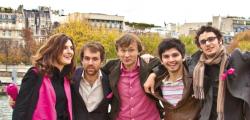
Prague library. Photo by Hieu Vu Minh –Unsplash
10 Facts About The Klementinum Library in Prague
The Klementinum library, a magnificent exemplar of the Baroque architectural style, was founded as part of the Jesuit university in 1722 and now houses over 20,000 books. Our readers chose it as one of the finest and most stunning libraries on the planet.
Jan Hiebl painted the roof murals in this Prague library. Karel Rafael Ungar founded the Biblioteca Nationalis, a selection of Czech language literature, in 1781. Some of the unique historical books have been sent to Google for screening and will someday be available on Google Books.
The Prague library is a unique and somewhat a masterpiece and it is affiliated with many little-known facts: the Klementinum was once the world’s third largest Roman catholic college; weather forecast documentation started there in 1775 and has kept going since then, and it is showcased in a book by famous Spanish author Jorge Luis Borges.
Read more on; 5 Most Beautiful Libraries in Prague
1. A brief history lesson on the Klementinum Library in Prague
The Klementinum has a lengthy and deep history and it is still an honorable core of culture and learning for Prague and the Czech Republic in general. The Jesuits, affiliates of the Catholic Church’s male religious crowd known as The Society of Jesus, established the structure in 1556. The Jesuits began renovating the structure in the 17th century, a process that took more than 170 years. As a by-product, building structures contain a wide range of architectural elements. In the Klementinum, the Jesuits built a school, a library, a pharmacy, a theatre, and of course, a religious center. The Klementinum university combined with the world-famous Charles University in 1654 and the Charles-Ferdinand University stayed in the Klementinum despite the Jesuit action being abolished and its members being ordered to evacuate in 1773. The Klementinum became the home of the National Library in 1930.
PRACTICAL INFORMATION
BOOK WITH US: PRAGUE TOUR
2. John Amos Comenius’s exhibition of his famous Comenius Map of Moravia in Prague
John Amos Comenius (who died about 350 years ago) was a remarkable man who gave the universe a fresh outlook on teaching methods. He was a cartographer as well as an educator, philosopher, theologian and author. His Map of Moravia is an intriguing work that has appeared in different global atlases for the past 150 years. Comenius did not have sufficient time to gather information if it was first published in 1624. He was only 32 years old, and the map is proof of his adaptability, skill and tenacity. The map depicts 1,006 objects in total, including individual mountains and mountains, forests and rivers, marked bridges, healing springs and spas. There are also glassworks and iron ore mines, as well as gold and silver mines and vineyards. The most famous mapping work of the Czech lands of all time, Comenius’ Map of Moravia, was not released in the Czech lands until 1677. We don’t know the number of copies of the Comenius Map of Moravia have survived however, the Comenius Museum in Perov is one of the world’s largest shareholders, with many dozen copies.
PRACTICAL INFORMATION
BOOK WITH US: PRAGUE TOUR
3. A brief explanation of the tours offered in the Klementinum Library in Prague

Library in Prague, Czech Republic. Photo by Jonathan Francisca- Unsplash
Only guided tours of the Klementinum allow access to the Baroque library hall, the Meridian Hall, which was employed to accurately estimate noon, and the astronomical tower with a height of 68 meters, which provides a lovely scenery of the old town of Prague in all angles. During the tour, you can also see a simulacrum of the Visegrad Codex and peer into the Mirror Chapel if there are no other events going on. Each tour should last about 50 minutes and is led entirely by a guide. Tours are given in both Czech and English. The tour begins in the courtyards of the Klementinum, close to the Astronomical Tower. There are also ticket offices where you can purchase tickets.
PRACTICAL INFORMATION
BOOK WITH US: PRAGUE TOUR
4. The real beauty of the library and why it is so famous worldwide
Pay close attention to the small details on the library’s walls and ceilings as you walk down the hall. You will enter a beautiful room with bookshelves closely allied all along the hall and captivating works of art and illustrations displayed on the walls. The details and decorations found in the library hall and on the bookshelves date back to 1700. What’s more intriguing is that they haven’t been renovated since.
As you walk down the library hall, you will notice a dozen hand-crafted world globes among the books. They are genuine pieces of art. There are also astronomical clocks designed by a Jesuit astronomer, Jan Klein, in the global collection. Moving on to the hall’s magnificent roof, once you enter the library hall, pause and gaze up. You will notice that the hall has its own high-ceiling balcony constructed of wood and gold, in addition to artwork by Jan Hiebl. This gifted German painter chose to make a one-of-a-kind masterpiece out of his frescos by fusing science and religion for artistic expression.
PRACTICAL INFORMATION
BOOK WITH US: PRAGUE TOUR
5. Make sure you have a look at the incredible astronomical tower that tells the weather
Visitors can also explore other attractions. Weather forecasting readings are still taken at the monument. A viewing platform is open at an altitude of 68 meters, from which old Prague is plainly apparent. You can reach the viewing platform by taking a lift to the third floor and then walking 87 steps. The Meridian’s room is located close to the viewing platform. As a center point, a thread is used; at noon, a solar bunny drops on it, which goes through a hole in the wall. With a raised flag, this occasion is disclosed to local citizens on a daily basis. There is also a showcase of old astronomical tools and files describing the tower’s record.
Read more on; 30 Best Things to do in Prague, Czech Republic
PRACTICAL INFORMATION
BOOK WITH US: PRAGUE TOUR
6. Pay a visit to the Meridian Hall and discover more about Prague’s historical background

A young girl reaching for a book. Photo by Rabie Madaci- Unsplash
Meridian Hall is on the second floor, directly above the Baroque Library Hall. It was used for evaluating, calculating, and determining the time of day. There is a string running throughout the room that serves as a Prague meridian, and when the sunlight touches the string, it signals the arrival of noon (12 a.m.). In 1928, the last noon measurement was rerecorded. Aside from the noon string, there are a few astronomical tools located in Meridian Hall’s southern and northern walls. The angular spacing between objects in space and their height above the horizon were measured using two wall quadrants.
PRACTICAL INFORMATION
BOOK WITH US: PRAGUE TOUR
7. There is a tour of the Mirror Hall, a chance to learn a lot more about Prague’s history
Kilian Ignaz Dintsenhofer, a Czech architect with German ancestors, is the project’s creator. Mirrors built into the walls and complementing the stucco molding gave the hall its name. The overall focus of the room’s design is the Blessing of the Virgin Mary. Two organs are kept in the chapel, and they sound great in unison thanks to the hall’s outstanding sound quality. It was one of the musical instruments created in the 18th century and was used by Mozart.
PRACTICAL INFORMATION
BOOK WITH US: PRAGUE TOUR
8. There is a tour of the Churches and Chapels, a chance to learn a lot more about Prague’s history
As the Klementinum facility was established by the Jesuits, it probably contains some incredible religious structures. The Cathedral of St. Clement, a Baroque church constructed between 1711 and 1715, has an unusual combination of a simple exterior and an extremely extravagant ambiance. The church’s most valued attractions are statues by renowned Matthias Braun and a mural by Petr Brandl. The major Jesuit church, the Church of the Holy Savior, was constructed in the 17th century and impresses with its lovely dome adorned with marvelous stuccoes. Its most fascinating charm is possibly the Italian Chapel of the Assumption of the Virgin Mary. It was constructed between 1590 and 1597 for the advantage of the Italians who lived in Prague.
PRACTICAL INFORMATION
BOOK WITH US: PRAGUE TOUR
9. A few more reasons why this is among the most beautiful libraries in the world
The Baroque Jesuit Library in Prague’s Klementinum has been defined as the world’s finest library on numerous occasions. It was designed by the wizard of Baroque architecture Kilián Ignác Dientzenhofer, and it first opened in 1722 for the purposes of the Jesuit University. Its presence has remained relatively unchanged since then. It houses 20,000 volumes of mostly foreign-language theological literature, with gentrified spines and red marks dating back to the Jesuit era. Aside from the books, there is a catalog of historical globes, including astronomical clocks. The Jesuit Library in Klementinum has become one of the pillars of the Czech Republic’s National Library, the state’s biggest library and one of the country’s oldest public libraries. The responsibility for Prague book printers to send a copy of each book they generated to the Prague Library began in 1782. It was extended to printers across the whole of Bohemia in 1807 and still appears to apply to publishers today.
PRACTICAL INFORMATION
BOOK WITH US: PRAGUE TOUR
10. One of the most peculiar novels stays in this National Library

Prague library. Photo by Hieu Vu Minh –Unsplash
Aside from the Devil’s Bible and Voynich’s manuscript, the most enigmatic manuscript is Liber sapientiae / The Book of Wisdom, a witch’s book written in German and Latin. It was established in the middle of the 18th century and its writer even signed himself, yet his identity is still unknown: he used the fictitious name of a hidden teaching adept. The manuscript sums up the Hermetic sciences’ individual disciplines: theoretical magic, Kabbalah, alchemy, and later practical magic with instructions for summoning fallen angels and demons. A range of educational pictures, full of complicated symbolism and secret messages, supplement the work. The book’s story to the National Library was also strange: arrived during Emperor Joseph II’s reign.
Read more on; 10 Reasons why you should book a Free Walking Tour in Prague
PRACTICAL INFORMATION
BOOK WITH US: PRAGUE TOUR
Take advantage of these free walking tours to the library once you’re in Prague.

 English
English








